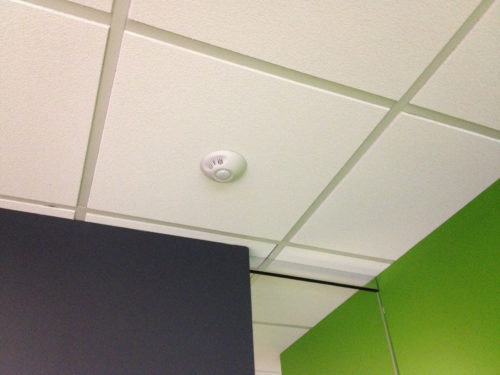Increasing the Energy Efficiency of Your Facility With Occupancy Sensors
Occupancy sensors are detection devices that identify the presence or absence of a person or persons and adjust the environment accordingly. Depending on the configuration of the occupancy sensor, when it detects someone in a room, it can automatically signal the room’s lighting, HVAC, and/or other systems to turn on.
Once it detects the room is empty, it turns these systems off. More advanced occupancy sensors offer the option to toggle between different modes, such as automatic, vacant, or occupied settings.
What Is an Occupancy Sensor?
By implementing occupancy sensors in their facilities, industry professionals can optimize airflow and lighting control within their workspaces, reducing overall energy usage and costs.
Types of occupancy sensors available include:
- Passive infrared (PIR) sensors. These sensors work by monitoring the level of infrared radiation in a room. If an object, such as a person, enters the area and exhibits a different temperature than the baseline, the sensor triggers the programmed system response.
- Ultrasonic sensors. Ultrasonic sensors emit high-frequency sound waves, which bounce off of objects in the room and reflect back to the sensor. When the reflection patterns change constantly, the sensor determines that someone is present and activates the appropriate system. Unlike PIR sensors, ultrasonic sensors don’t require an unobstructed line of sight to function and can detect individuals who are behind barriers or around corners.
- Microwave sensors. Microwave sensors function similar to how ultrasonic sensors do. However, instead of utilizing sound waves, they emit high-frequency microwaves. The reflection of the waves is used to determine the room’s occupancy status.
- Smart meters. Smart meters monitor changes in a room’s power consumption levels to determine whether the room is occupied.
- Environment sensors. Environment sensors respond to changes in environmental variables that occur when someone is present, such as an increase in carbon dioxide, humidity, or temperature levels.
Differences Between Occupancy Sensors and Vacancy Sensors
Occupancy sensors respond to the presence and absence of an occupant. When someone enters the room, the sensor automatically triggers the connected system(s) to turn on. Once they leave the room, the sensor turns the system(s) off.
On the other hand, vacancy sensors only respond to the absence of occupants. Anyone entering a room with a vacancy sensor has to turn the systems on manually. When the vacancy sensor detects that the room is empty again, it then turns these systems off.
Occupancy sensors and vacancy sensors employ different operating mechanics but offer similar results—i.e., lower energy usage and costs. One advantage of vacancy sensors is that they cannot accidentally be triggered to turn lighting or HVAC systems on, resulting in even lower energy costs. However, occupancy sensors allow for more streamlined control over airflow and lighting, making it easier to maintain a comfortable work environment.
Differences Between Occupancy Sensors and Motion Sensors
Occupancy sensors respond to the physical presence of a person in a room, whether or not that person is moving. Motion sensors respond to movement alone and cannot detect individuals at rest.
When a motion sensor detects movement, it turns on the systems. When that movement stops for more than a set amount of time, the sensor turns the systems off again. If a person remains still for long enough—for example, if he or she is sitting at a desk reading materials—the motion sensor will turn the lights, ventilation, or other environmental systems off, even though they are still present in the room.
Industry professionals employ both types of sensors to improve the energy efficiency of the HVAC and lighting systems. However, occupancy sensors offer greater functionality than motion sensors, while motion sensors are available at lower costs than occupancy sensors.
Occupancy Sensors From Alan Manufacturing
Since our company’s establishment in 1992, the team here at Alan Manufacturing has designed more than one thousand standard HVAC industry products. Along with our long history of selling industrial products, we have also sold occupancy sensors that optimize lighting and airflow control to go along with our dampers.
We offer high-quality products, competitive prices, and attentive customer service.
To find out more about how our HVAC products can improve airflow and reduce energy costs in your workspaces, contact us today.

